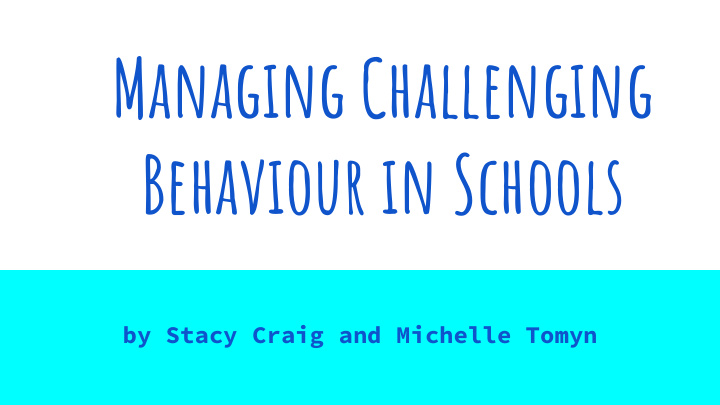



Managing Challenging Behaviour in Schools by Stacy Craig and Michelle Tomyn
What kinds of challenging behaviours are we seeing in our schools? Extreme defiance ● Anger ● Physical/emotional outbursts directed ● towards teacher, other students or classroom materials/furniture Inappropriate language ie. swearing or ● name-calling Withdrawal ● Anxiety ● ● http://www.thekidswelose.com/
How is this affecting our schools? Challenging Students: low-self esteem, self-worth, self-confidence, unable to self-regulate, ● loss of friends, needs not met, stress, frustration, depression, unsure how to voice the issues, safety, loss of instructional hours Other Students: confusion, anxiety, fear, distracted in learning, safety, instructional hours ● affected Teacher: unsure how to deal with needs of all students, stress, worry, anxiety, fear of reflection ● of teaching competence from adminstration, collegues, and parents, loss of instructional time, safety, extra meetings, workload increases due to implementation of possible numerous IIP’s, energy drained, affecting home-life, teacher burn-out ● Parents/Families: concern, worry and anxiety for their child’s safety and what their child is seeing, trauma of own school experiences, fear of reflection of their parenting and repercussions of the challenging child’s behavior.
According to Ross Greene, the skills our behavioural, challenging kids lack are: Executive skills (enable us to ● plan, focus attention, remember instructions, and juggle multiple tasks successfully ● Language Processing /Communication Skills ● Emotion Regulation Skills (the ability to recognize that you are having an emotional response and to understand that response Cognitive Flexibility Skills ● ● Social Skills
So what is the solution? How can we help those who are experiencing challenging behaviours in the school?
What does the Collaborative Proactive Solutions Approach look like in action? ● Identify the skills that are lacking in the child you're trying to understand and help. ● Identify the “unsolved problems" in which challenging behavior is occurring. Then you can utilize the three basic steps of the CPS approach: ● 1. The Empathy 2. Define the Problem 3. The Invitation
Scenario
What does research say about the Collaborative and Proactive Solutions approach? He argues that the goal of Even when a student (or an adult) is “The basic premise of CPS parenting is to shape our "acting out" or "clearly in the wrong," the is Greene's mantra that children’s long-term development fastest way to calm them down, so one “kids do well if they can” by influencing the calibration of can create a teachable moment or and that 90% of children their internal moral compass, have a rational conversation, is to offer and adolescents admitted rather than asserting adult power them empathy first and correction or to psychiatric inpatient to forcefully guide them. Greene discipline second. units already know that states that this objective can be aggressive behaviors are accomplished through CPS or, wrong (Greene, 2006)” what he refers to as “Plan B.” “The kids do well if they can” philosophy carries the assumption that if a kid could do well he would do well. If he’s not doing well, he must be lacking the skills needed to respond to life’s challenges in an adaptive way”. (Lost at School p. 11)
What are some solutions to the challenges associated with making these changes?
Resources https://www.facebook.com/groups/LITBLostandFou https://www.livesinthebalance.org/sites/default/fi ➔ ➔ nd/ les/2017%20Full%20Day%20Version%203.pdf https://www.livesinthebalance.org/listening-libra www.thekidswelose.com ➔ ➔ ry-helping-behaviorally-challenging-students https://www.pesi.com/store/detail/7106/explosive- ➔ ➔ https://www.livesinthebalance.org/voices-solving- noncompliant-disruptive-aggressive-kids-what problems-collaboratively https://www.youtube.com/watch?v=jvzQQDfAL-Q&li ➔ st=PL96FCD5F40215BB70 www.livesinthebalance.org ➔ https://www.livesinthebalance.org/walking-tour-e ➔ ducators
Kumashiro gives us... “Our hidden lessons demonstrate how it is that oppression can play out in our lives unnoticed and unchallenged, and our lenses of analysis demonstrate why it is that we often desire making sense of the world in only certain, comforting So what are the hidden messages ways. They are not the barriers to our students get from punitive anti-oppressive education; rather,they discipline and external rewards? are what help us to make It’s time to unlearn what we’ve anti-oppressive education thought to be true. possible”(p.41). ...things to consider.
Some Comic Relief...
References Algon, S. (2019). Ross Greene Raising Human Beings: Creating a Collaborative Partnership With Your Child 2016 Scribner New York, NY. Journal of the American Academy of Child & Adolescent Psychiatry, 58 (2), 299-300. Ercole-Fricke, E., Fritz, P., Hill, L., & Snelders, J. (2016). Effects of a Collaborative Problem-Solving Approach on an Inpatient Adolescent Psychiatric Unit. Journal of Child and Adolescent Psychiatric Nursing, 29 (3), 127-134. Kumashiro, K. (2009). Against Common Sense. New York: Routledge Kumashiro, K. (2008). Lost at School. New York: Scribner Liepe-Levinson, K., & Levinson, M. (2005). A GENERAL SEMANTICS APPROACH TO SCHOOL-AGE BULLYING. Et Cetera, 62 (1), 4-16.
Recommend
More recommend